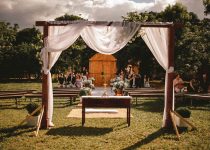What Tips Ensure a Balanced Landscape Lighting Setup?
When it comes to creating a balanced landscape lighting setup, you need to start with a clear understanding of your outdoor space. Think about which areas and features should be highlighted. Choosing the right fixtures is equally important, as they should align with your home's style and energy efficiency goals. But it doesn't stop there—layering different types of lighting can make a significant difference. Ready to explore how to bring all these elements together?
Table of Contents
Key Takeaways
- Assess your outdoor space to identify key features and areas needing more light for a balanced setup.
- Choose fixtures that align with the style of your home and serve specific purposes like pathways or highlights.
- Layer different types of lighting, including ambient, task, and accent, to create depth and visual interest.
- Focus on safety by illuminating walkways and entrances, and consider motion-sensor lights for added security.
- Regularly maintain your lighting fixtures to ensure consistent performance and adjust brightness levels as needed.
Assessing Your Outdoor Space
Before you dive into lighting your outdoor space, it's essential to assess what you have.
Take a walk around your yard and note the natural features, existing structures, and any plants that deserve attention. Identify areas that feel dark or uninviting and consider how you want to use these spaces.
Think about the mood you want to create—are you aiming for a cozy atmosphere for gatherings, or do you want to highlight your garden's beauty?
Don't forget to evaluate the layout and pathways, ensuring they're safe and welcoming.
By understanding your outdoor environment, you'll lay a solid foundation for effective lighting choices that enhance both function and aesthetics.
This assessment is your starting point for a balanced landscape lighting plan.
Choosing the Right Fixtures
How do you choose the right fixtures to illuminate your outdoor space effectively? Start by considering the purpose of your lighting. Are you highlighting pathways, trees, or architectural features?
Next, think about the style of your outdoor area. Fixtures should complement your home's design, whether it's modern, traditional, or rustic.
Then, evaluate the brightness and type of bulb. LED options are energy-efficient and long-lasting.
Finally, don't forget about durability; choose fixtures that can withstand weather elements. Aim for a mix of up-lighting and down-lighting to create visual interest.
Layering Light for Depth
When you layer light effectively, you can transform your outdoor space into an inviting retreat.
Start by combining ambient, task, and accent lighting to create depth and dimension. Ambient lighting provides overall illumination, while task lighting focuses on specific areas, like pathways or seating. Incorporate accent lighting to highlight trees, sculptures, or architectural features, adding visual interest and character.
Experiment with different heights and angles to achieve a balanced look, ensuring no areas are overly bright or dim.
Using dimmers can help you adjust the intensity based on the time of day or occasion. By thoughtfully layering your lights, you'll create a warm, welcoming atmosphere that enhances your landscape's beauty and functionality.
Focusing on Key Features
As you design your landscape lighting, focusing on key features can elevate your outdoor space's appeal. Identify the elements that stand out in your yard, like trees, pathways, or architectural details.
Use spotlights to highlight beautiful trees, casting shadows that add depth and drama. For pathways, consider soft lighting to guide guests while creating a warm ambiance.
If you have a water feature, underwater lights can enhance its beauty and reflectivity, making it a focal point at night.
Prioritizing Safety and Security
While enhancing your outdoor space with strategic lighting, it's important not to overlook safety and security. Well-placed lights can deter intruders and make your property feel more inviting.
Start by lighting walkways and entrances to ensure guests can navigate safely at night. Use motion-sensor lights in darker areas to alert you to movement, adding an extra layer of security.
Avoid harsh glare by choosing fixtures that direct light downward, preventing unwanted shadows. Incorporate ambient lighting in your landscaping to enhance visibility without overwhelming brightness.
Regularly check and maintain your lights to ensure they're functioning properly. By prioritizing safety and security in your lighting design, you create a welcoming environment while protecting your home and loved ones.
Frequently Asked Questions
How Do I Determine the Ideal Brightness for My Landscape Lights?
To determine the ideal brightness for your landscape lights, consider the area's purpose, surrounding features, and desired ambiance. Test different wattages and adjust until you achieve a harmonious balance that enhances your outdoor space.
Can I Use Solar Lights in Shady Areas?
You can use solar lights in shady areas, but their performance might be limited. Consider placing them where they'll receive some sunlight or choose solar lights designed for low-light conditions to improve their effectiveness.
What Are the Best Colors for Outdoor Lighting?
When choosing colors for outdoor lighting, opt for warm tones like soft white or amber to create a welcoming atmosphere. Cool colors, such as blue or green, can add a modern touch to your landscape.
How Often Should I Replace My Landscape Lighting Fixtures?
You should replace your landscape lighting fixtures every 5 to 10 years, depending on the quality and exposure to elements. Regularly check for any damage or dimming to ensure your outdoor space stays well-lit and inviting.
Are There Energy-Efficient Options for Landscape Lighting?
Yes, there are energy-efficient options for landscape lighting. You can choose LED fixtures, solar lights, or low-voltage systems. These choices not only reduce energy consumption but also lower your electricity bills while enhancing your outdoor space.



